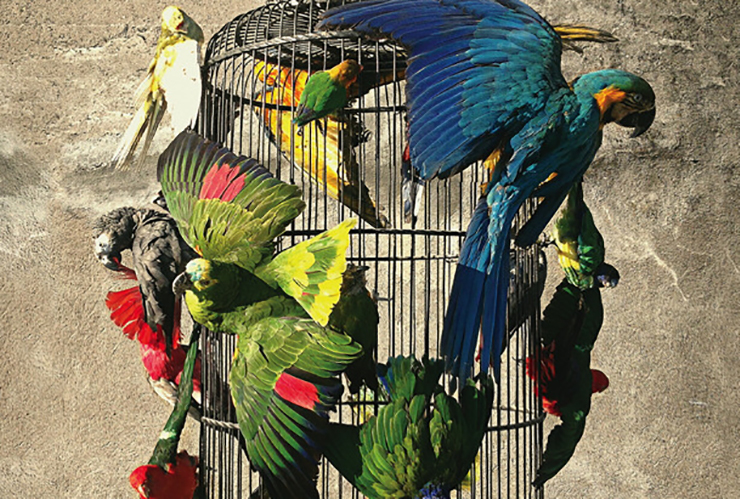
Personal Science, Lillian-Yvonne Bertram’s third collection of poetry, takes us into the world we are already living in: the fear of planes and weather is real, the complications with brothers and lovers is real, the Internet searches are real, as are the discoveries and doubts and imaginative facts that come with their results. Betram’s poem “Year of the cyclone” brings together science and superstition and refuses to decide between them: “It is said that what follows cannot be proven. / Like a barn came up and smack smacked me / that’s Midwest. / Or disproven. They called it / year of the cyclone.” With resolute doubleness, Bertram’s verses insist on the mutual influences between the world of the mind and the world outside; these lines move fluidly, flagging uncertainty but not dismissing it. Several pieces share titles: there are four poems called “Legends like these I keep keeping” and nine called “Homo Narrans.” The effect is a fusing together of different aspects of a moment, which leads to the possibility of deeper study. In “Forecast” Bertram writes, “And if there was a terrorist on the plane, what would she do? Would she alert someone to something suspicious? Would she see something, say something?” The connections between raising such questions as part of existing in the world or as the prelude to the poet’s research reflect the way selves are shaped by imagination as well as by experience. So many contemporary books, poetry and otherwise, use the formal constraints of the Internet Age: its syntax and grammar, its language, and its surreal tendency toward combinatorial dynamics that relate the unrelated in ways only a machine can conjure. In “The gunslinger neuron” Bertram writes: “Everyone should get in touch with their inner fate / of snow affiliated by a bad case of doldrums. / Reader, I would not live in a powderless tree: If I could / I would align myself with the powerscape.” Bertram’s searches may be particular to the ubiquity of our external cloud brains but her search for herself is rooted and particular.
—Hannah Rogers

At once intimate and historical, Burwick’s slim Custody of the Eyes elegizes Franco’s stolen babies—the 300,000 infants abducted from their Republican parents shortly after their births between 1950 and 1980 and sold to Loyalist families. With an incongruity of scale that bespeaks the inestimable depth of these losses, the poems rely on spare lyric glimpses, meditative beads on the string of an account of one way an oppressive regime took its toll on individual lives. Returning repeatedly to the image of a frozen baby—a corpse kept on hand for hospital staff to show the mothers as false evidence of stillbirth—Burwick transposes the lament onto other, more personal griefs: “The freezer-babies all / night long in their fathoms / of pewter like a rhapsody / I cannot take.” The motive and compulsion to take up this sorrow derives from the speaker’s own experience—“Because I saw your birth, I am responsible for all the dead”—and the nearness of grief is made palpable. These illegal adoptions for cash had their roots in a program of racial and political cleansing, but the poems focus on the present-tense particulars of acute vulnerability and fear. The speaker bewails the incommensurability of circumstance: “I’ll eat the flies the angel / left behind, the sour milk / in a deviled landscape spoken / only as salvia with quail.” The crushing weight of repression, and the complicity of supporting institutions that made it possible, yields to a memorializing gesture where devastating loss is familiar and near at hand: “Of everything plural between us, verdigris / beribboned like a beautifully amputated / God in a Sunday service, the angel’s clean / hand a sort of doll’s arm the wind takes whole, / only a little violence in that action of green.”
—BK Fischer
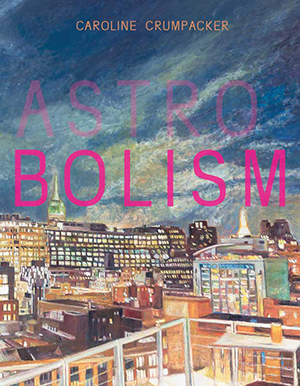
Caroline Crumpacker’s Astrobolism is designed to atrophy the language of emotion and build a new architecture of desire patterned and diagrammed for paralysis: “There is no such thing as freefall / but uncertainty is the same thing / unless we train our minds.” This poetic design creates a predicament for the reader: how do we train our minds to read the esoteric body of poems that comprises Astrobolism so we don’t freefall while atrophied? Will she suggest logic or plurality or maternity? Working in a mode that may appear counterintuitive, Crumpacker uses noetic language—the language of intellect—instead of the language of instinct to create a new home for writing about motherhood and about the indecisions born from the plurality and paradox of choices. These poems suggest that indecision or instinct has to be lured, not as a blind gesture, but as an effort to overcome the impasse that the “plurality of many choices” is a condition of “one choice.” Her work limns the diverse landscapes and the “corporeal edge” of nebulous experiences, and her “seated opera” of words may appear to freefall from the ceiling of “urban reverie”—a reverie intended to satiate and collapse our consciousness, from “lavender coquette” to “veiled catastrophe.” Even if her words do not energize us with their “unspeakable condition” or blankness, they invite the reader to grant meaning to things they cannot possibly understand. The poems invite the reader to engage with vectors of “animal logics” and a primal vernacular, assigning new meanings to new things as a “trial run.” The new mother, in this text, is the one who uses logic to defy logic, and applies indecision to generate open-ended instinct. Crumpacker’s poetry, shaped to stymie sugary sentiments, allows the reader to unlearn and uncreate, as if meaning were unborn from its own kinetic womb. By the time you exit her work, you have become a clairvoyant: you see beyond something that has been atrophied.
—Vi Khi Nao
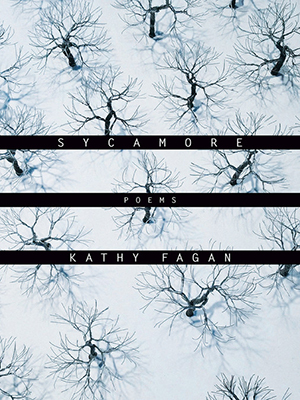
The opening poem in Kathy Fagan’s Sycamore aptly references an aria from a Verdi opera steeped in pain and sorrow. In these potent, wrenching poems, “nothing is beautiful, / & it is always 4 o’clock on a Sunday,” because the speaker’s forever-lover has suddenly left her. Deeply stunned, she finds nothing cheery in the landscape’s wintry mix, where “It is always someone’s last day” and “the sledding hill is closed.” Traversing grief-laden terrain, the speaker finds that her sense of self has been obliterated. “I cast no shadow,” she opines in “Sycamores at High Noon,” noting that “vertically I barely creak in wind.” Poems address demolition, Antarctica’s desolate landscape, and the realization that shooting stars are “neither / star nor blue. Just space / junk”: bleakness accrues like the snow that blankets the ground beneath bare branches. In one of several self-portraits of sycamores (“Sycamores Stacked in Lengths & Pieces”), Fagan gorgeously characterizes her grief as “[m]assive as Constantine’s knees . . . More stone than wood . . . More flesh than stone.” As the book progresses, the speaker’s outlook thaws, and statements such as “I fell from there to here / with the velocity / of a fat, hot tear” give way to optimistic glimmers (“my leaves fell . . . but I grew new ones”). In “Black Walnut,” she notices how a river, perhaps like her soon-to-be-healed self, does not “fear / Bridges . . . It’s got its banks, its silt, its delta, / Its nuts, its bark, its currents, its tenants.” Sycamore delights as much in its close inspection of the natural world as it does in the auditory pleasures of its language. “Sycamore. Sick amour. Seek no more,” the speaker recites, and we know we are in the hands of a gifted word master. “Though they are not a choir . . . not Kabuki,” the trees become a temporary stand in for love, for her “amours,” providing the solace and steadiness necessary to stage a rebirth.
—Martha Silano
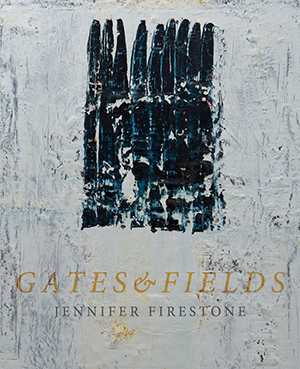
Gates & Fields evokes both lyrical continuity—perception through gate to field—and crystalline juxtaposition, the paratactic magic of rubbing gate and field together. Both approaches resonate, and together recall the poetic field of Robert Duncan’s Often I Am Permitted to Return to a Meadow: “an eternal pasture folded in all thought.” In Firestone’s poems, we meet ghosts and encounter selves as ghosts: the final poem, “Author’s Note,” explains, “Voices—they may have been ghosts. They sang and instructed. / A woman from another time appeared. She was working in a field. / She was trying to rid herself of ghosts. / She was a ghost.” Gates & Fields takes its measure from its epigraph, a line from Emily Dickinson’s “Because I Could Not Stop for Death”: “The Carriage held but just Ourselves.” Dickinson serves as Virgil, preempting Firestone’s rhythm as she makes it meaningfully her own. The rhythmic field that the Dickinson epigraph calls into view announces both a realm of possibility and a realm of repletion—witness of what may have been ghosts, and the abundance of ghosts of which she tries to rid herself. Both repletion and possibility lie nested within the woman working in a field, a ghost in a living uncertainty, true to the dynamic proposed by Firestone’s formal relationship with Dickinson. Firestone’s language emerges within this dynamic uncertainty, and the vital connection of her language to the woman in the field is the articulate “gate” of her freedom, the locus of the poet herself. As she writes in the section “She”: “The carriage gathers thoughts lifts them to the sky as birds / The sky as birds the carriage leads, the sky as birds the carriage leaves.”
—Tamas Panitz
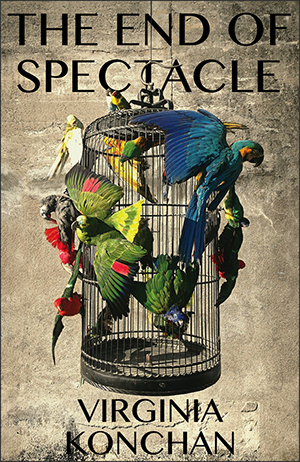
Cultural theory can reveal the hidden mechanics in everything from gender roles to profiteroles. It can also inform poetics. Virginia Konchan’s The End of Spectacle grapples with the concept of spectrality, articulated by the Marxist Guy Debord forty years before the iPhone: commodities ultimately rule their consumers, impoverishing social relationships and enthralling us to mass media. Konchan’s poems—wryly absurdist and surgically acute—explore this predicament, resurrecting John Keats and Mary Shelley, Thomas Benton and Jackson Pollock, Zsa Zsa Gabor and Dolores Haze (aka “Lolita”) in a campy séance and critique of lyric subjectivity. She creates, in Debord’s terminology, “situations” that denude the spectacle or catch us in the commodifying act. In “Elegy for Whitney Houston,” the speaker notes, “The reaper turned out to be lively, / tossing out ripostes like burgers at / a fundraiser for teens” before wishing “that I could wake / you . . . call you . . . / . . . by any other name.” Remixing elegiac apostrophe, Konchan lends interiority to cantankerous midcentury painters, Hollywood starlets, teenage girls, and iconic musicians, all fetishized as objects of desire. Indeed, her collection centers on the “life-wound / of becoming-object.” In “Shostakovich’s Fugues,” the narrator pleads, comically, “Dear demonology, / I want to be free / from hebephiles, slave labor, / and shrunken miniskirts.” More literal deformation of the body appears in “Romance of the Hand and Thumb,” in which the “nimble fingers” of factory laborers “dehisce, reattach / to wrists, arms, then torsos” as they sew buttons with speed. Working against commodification, symbolized in the bodies of factory workers, amputated to become faster machines, Konchan takes up Daphne’s “rebellion from the god of / sex: rights reverting, after / the production of desire, / to you, and me, and trees,” and she leaves us in that dark-lit grove.
—Heather Treseler
